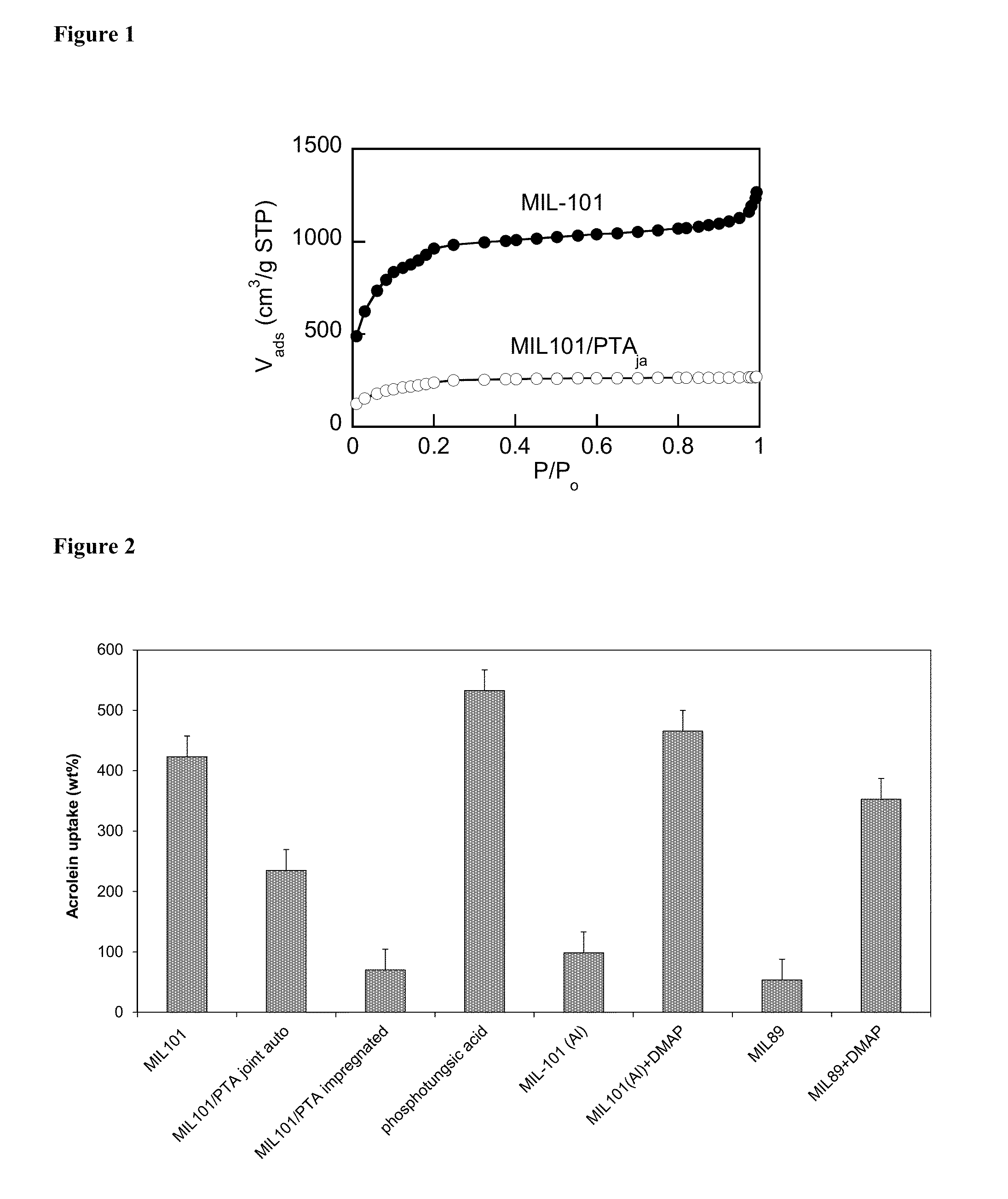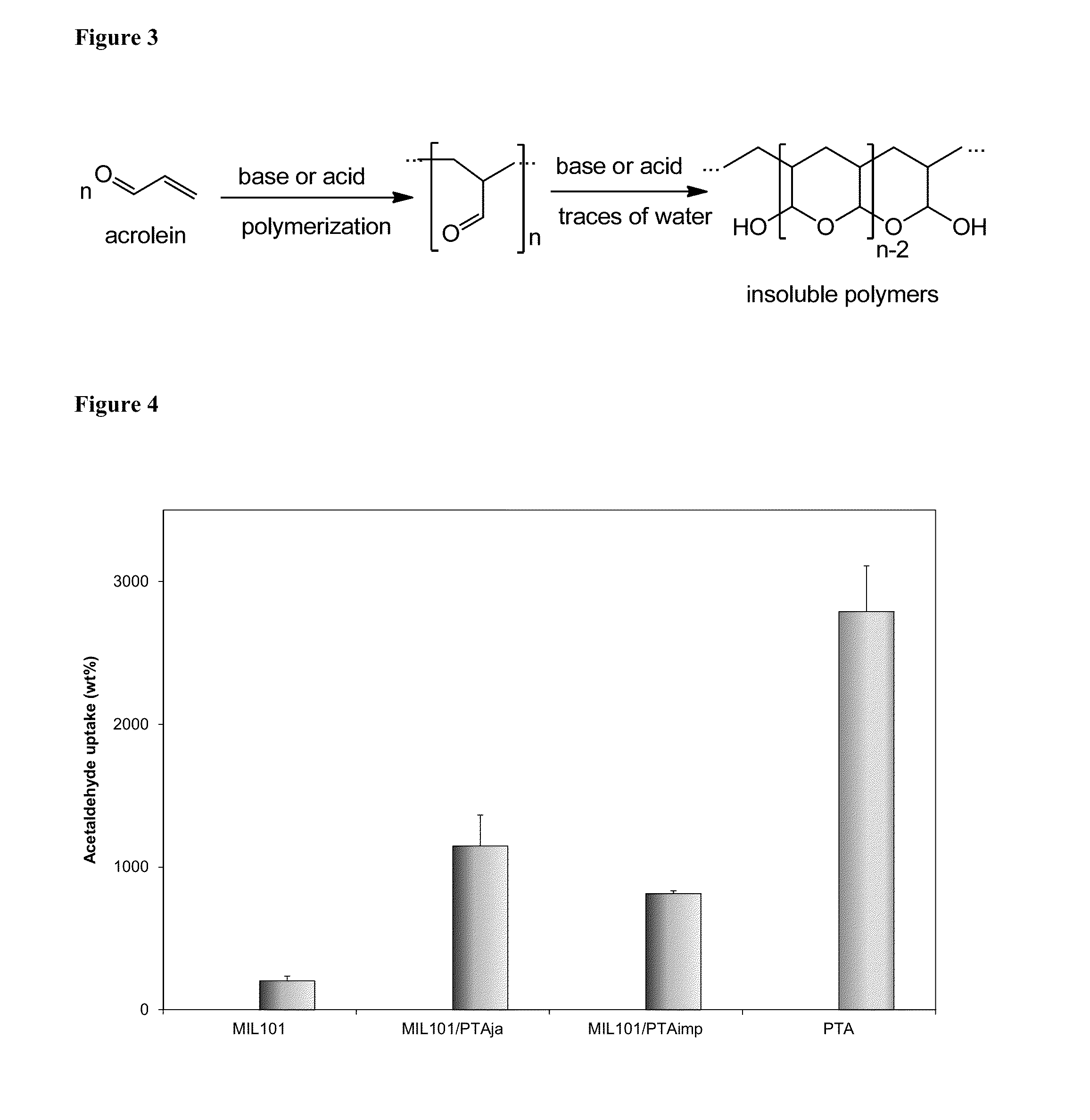Porous Catalytic Matrices for Elimination of Toxicants Found in Tobacco Combustion Products
a catalytic matrice and toxicant technology, which is applied in the direction of organic compounds/hydrides/coordination complex catalysts, physical/chemical process catalysts, tobacco, etc., can solve the problems of not revealing any catalytic conversion methods, reducing the risk of asthma and cancer, and not revealing any catalytic conversion of volatile carbonylic compounds or phenols into less volatile chemicals, etc., to achieve the effect of reducing the quantity of toxicants
- Summary
- Abstract
- Description
- Claims
- Application Information
AI Technical Summary
Benefits of technology
Problems solved by technology
Method used
Image
Examples
example 1
Synthesis of Porous Catalytic Matrices
[0114]Materials
[0115]Chromium (III) nitrate nonahydrate (99%), terephthalic acid (≧99%), aluminum chloride hexahydrate (AlCl36H2O, 99%), acetaldehyde (≧99.5%), 2-amino terephthalic acid (99%), N,N-dimethylformamide (>99.9%), 2-naphthol (99%), benzaldehyde (purified by redistillation, ≧99.5%), β-caryophyllene (≧98.5%, sum of enantiomers, GC), methanol (anhydrous, 99.8%), phenol (≧99%) and acetamide (≧99.0%) were all obtained from Sigma-Aldrich Chemical Co. and were used as received. Hydrated 12-tungstophosphoric acid (H3PW12O40, PTA) (Sigma-Aldrich, >99%) was dried at 70° C. for 8 h to obtain H3PW12O40.6H2O. All other chemicals and solvents used were obtained from commercial sources and were of highest purity available.
[0116]Porous MIL-101 (Cr) Matrix Synthesis
[0117]Particles of metal-organic framework (MOF) MIL-101 were synthesized hydrothermally, utilizing either microwave (MW) or autoclave oven heat supply. In the autoclave method, Cr(NO3)3.9H...
example 2
Synthesis and Properties of NH2-MIL-101 (Al) porous material and NH2-MIL-101 (Al) doped with Dimethlaminopyridine (DMAP)
[0124]A solution of aluminum chloride hexahydrate (0.97 g, 4.0 mmol) and 2-aminoterephthalic acid (1.09 g, 6.0 mmol) in 30 mL of DMF was placed in a Teflon®-lined autoclave and kept there at 130° C. for 72 h. The resulting yellow powder was separated by centrifugation (10,000 g, 15 min), washed with acetone, separated and suspended in 200 mL methanol at 75° C. for 24 h. The resulting powder was recovered from methanol by centrifugation and dried under vacuum. MOF surface area and pore parameters were measured using a Micromeritics' ASAP® 2020 Accelerated Surface Area and Porosimetry Analyzer (Micromeritics Corp., Norcross, Ga.). The compound's BET and Langmuir surface area values were measured to be 2080 and 2880 m2 / g, respectively, and the average pore diameter was 2.2 nm.
[0125]For doping by DMAP, a solution of DMAP (1 g) in 30 mL methanol was added to 1 g of NH2-...
example 3
Synthesis and Properties of MIL-89 Porous Material and MIL-89 Doped with Dimethyaminopyridine (DMAP)
[0126]First, μ3-oxo-triaquohexakis(acetato)triiron(III)perchlorate dihydrate was prepared as follows: Electrolytic iron metal powder (11.2 g, 0.2 mol) was stirred with 100 mL of water and 51.6 mL (0.6 mol) of 70% HClO4. The mixture was warmed to 50° C. until all of the iron had reacted. A small amount of insoluble matter was removed by centrifugation. After the solution was cooled to 10° C., an excess (30 mL) of a 15% H2O2 solution was added. The solution was cooled to 5° C., and anhydrous sodium acetate (32.8 g, 0.4 mol) was slowly added with stirring. The reaction mixture was placed in a stream of air. After 5 days the majority of the solution evaporated, leaving large red-brown crystals; yield 7.99 g (30.0%). The crystals were collected, washed with two 25-mL portions of chilled water, and blotted with filter paper. The crystals were further dried for 24 h under vacuum at room temp...
PUM
| Property | Measurement | Unit |
|---|---|---|
| Temperature | aaaaa | aaaaa |
| Temperature | aaaaa | aaaaa |
| Volume | aaaaa | aaaaa |
Abstract
Description
Claims
Application Information
 Login to View More
Login to View More - R&D
- Intellectual Property
- Life Sciences
- Materials
- Tech Scout
- Unparalleled Data Quality
- Higher Quality Content
- 60% Fewer Hallucinations
Browse by: Latest US Patents, China's latest patents, Technical Efficacy Thesaurus, Application Domain, Technology Topic, Popular Technical Reports.
© 2025 PatSnap. All rights reserved.Legal|Privacy policy|Modern Slavery Act Transparency Statement|Sitemap|About US| Contact US: help@patsnap.com



